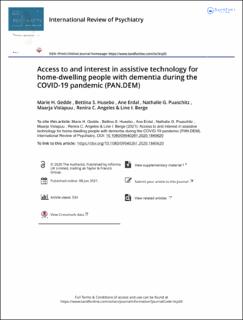| dc.contributor.author | Gedde, Marie H. | |
| dc.contributor.author | Husebø, Bettina | |
| dc.contributor.author | Erdal, Ane | |
| dc.contributor.author | Puaschitz, Nathalie | |
| dc.contributor.author | Vislapuu, Maarja | |
| dc.contributor.author | Angeles, Renira Corinne | |
| dc.contributor.author | Berge, Line Iden | |
| dc.date.accessioned | 2021-08-02T12:49:33Z | |
| dc.date.available | 2021-08-02T12:49:33Z | |
| dc.date.created | 2021-01-21T12:31:13Z | |
| dc.date.issued | 2021 | |
| dc.identifier.issn | 0954-0261 | |
| dc.identifier.uri | https://hdl.handle.net/11250/2765866 | |
| dc.description.abstract | The COVID-19 restrictions affect daily living in Norway, including home-dwelling people with dementia, and researchers conducting clinical trials in dementia care. In this paper, we 1) describe the development of a pandemic cohort (PAN.DEM) incorporated in the LIVE@Home.Path, an ongoing clinical intervention trial on resource utilisation including home-dwelling people with dementia and their caregivers (N = 438 dyads), 2) describe pre-pandemic use of assistive technology and 3) explore the extent to which COVID-19 restrictions increase caregivers interest in innovation in the PAN.DEM cohort (N = 126). Our main finding is that assistive technology is available to 71% pre-pandemic; the vast majority utilise traditional stove guards and safety alarms, only a few operate sensor technology, including GPS, fall detectors or communication aids. In response to COVID-19, 17% show increased interest in technology; being less familiar with operating a telephone and having higher cognitive functioning are both associated with increased interest. We conclude that wearable and sensor technology has not yet been fully implemented among people with dementia in Norway, and few caregivers show increased interest under the restrictions. | en_US |
| dc.language.iso | eng | en_US |
| dc.publisher | Taylor & Francis | en_US |
| dc.rights | Attribution-NonCommercial-NoDerivatives 4.0 Internasjonal | * |
| dc.rights.uri | http://creativecommons.org/licenses/by-nc-nd/4.0/deed.no | * |
| dc.title | Access to and interest in assistive technology for home-dwelling people with dementia during the COVID-19 pandemic (PAN.DEM) | en_US |
| dc.type | Journal article | en_US |
| dc.type | Peer reviewed | en_US |
| dc.description.version | publishedVersion | en_US |
| dc.rights.holder | Copyright 2020 The Authors | en_US |
| cristin.ispublished | true | |
| cristin.fulltext | original | |
| cristin.qualitycode | 1 | |
| dc.identifier.doi | 10.1080/09540261.2020.1845620 | |
| dc.identifier.cristin | 1876493 | |
| dc.source.journal | International Review of Psychiatry | en_US |
| dc.source.pagenumber | 404-411 | en_US |
| dc.relation.project | Norges forskningsråd: 273581 | en_US |
| dc.identifier.citation | International Review of Psychiatry. 2021, 33(4), 404-411 | en_US |
| dc.source.volume | 33 | en_US |
| dc.source.issue | 4 | en_US |

